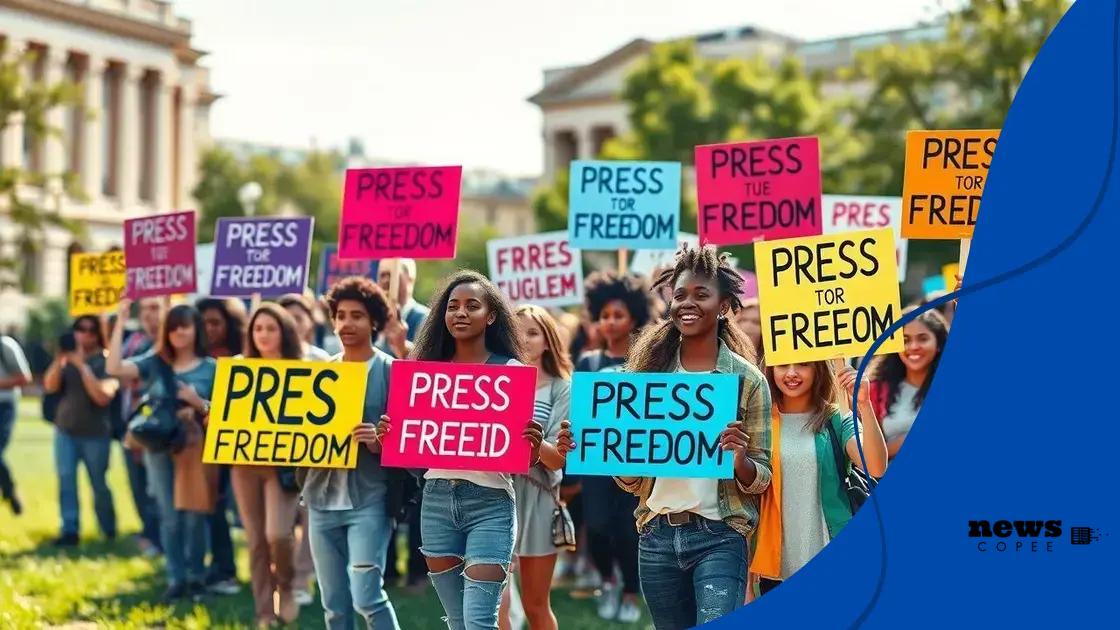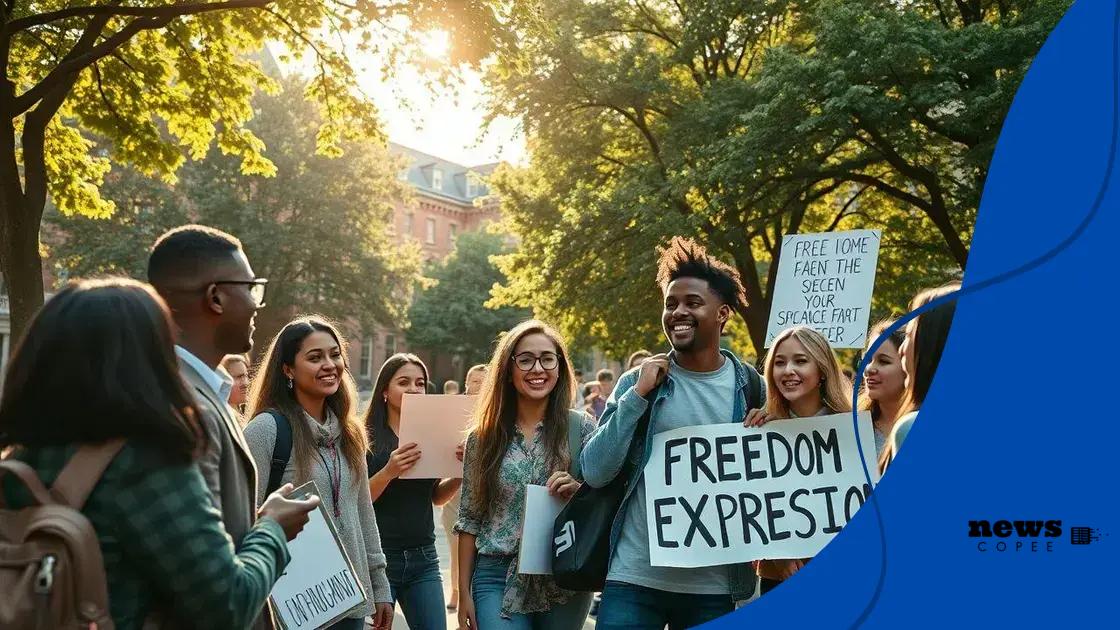Student media censorship protests arise across campuses

Student media censorship protests arise as students advocate for their rights to free expression, prompting varying responses from university administrations that can either support dialogue or impose stricter regulations.
Student media censorship protests arise as students demand greater freedom of expression. These movements highlight the ongoing struggle for legitimate platforms and open dialogue on campuses. What’s driving this surge of activism?
The roots of student media censorship
The roots of student media censorship run deep, often tied to historical events and the evolution of educational freedoms. Understanding these origins helps illuminate the ongoing struggles students face today.
Historical Context
Throughout history, educational institutions have grappled with the balance between maintaining order and allowing freedom of expression. Often, media censorship arises as a response to controversial topics or student activism, reflecting broader societal tensions.
Key Influences
Certain factors play a crucial role in shaping student media censorship:
- The political climate on campuses
- Administrative policies and regulations
- National events affecting public opinion
- Technological advancements in communication
As societal norms shift, so too do the boundaries of acceptable discourse within school settings. For instance, universities have become battlegrounds for ideas, raising questions about who gets to speak and who gets silenced. Additionally, recent movements focusing on diversity and inclusion have sparked debates about representation in student media.
Understanding the roots of student media censorship also requires looking at past incidents. In the 1960s, for example, students protested against the Vietnam War, leading universities to adopt stricter media policies to quell dissent. These actions often set precedents that impact current regulations.
As we examine these historical contexts, it’s clear that future generations will continue to fight for their right to express themselves freely. This ongoing dialogue emphasizes the importance of **media rights** within educational institutions as students push to redefine what’s permissible.
Key protests and movements
Over the years, numerous key protests and movements have highlighted the issues surrounding student media censorship. These events have played a critical role in shaping the conversation about free speech on campuses.
Notable Protests
Several significant protests have emerged in response to censorship attempts:
- The 1964 Free Speech Movement in Berkeley
- The student walkouts in response to the 1999 WTO protests
- Recent social media campaigns advocating for media rights
- On-campus demonstrations against restrictive policies
Each of these movements sheds light on the struggles students face and the need for open dialogue. In particular, the Free Speech Movement set the groundwork for many of the rights students now advocate for.
Additionally, as technology has advanced, so have the methods of protest. Today, students utilize platforms like Twitter and Instagram to mobilize quickly. They can spread awareness and gather support for their causes. These social media campaigns have proven to be powerful tools in fighting censorship.
As a result of these protests, many universities have had to reevaluate their policies. Increased engagement and advocacy from students are essential for fostering an environment where media freedom is prioritized. The collective voices of students echo the sentiment that open discourse enriches educational experiences.
Throughout history, the impact of organized student protests remains significant. They not only challenge existing norms but also pave the way for future generations to continue the fight for media rights. As new movements arise, they often draw inspiration from past successes, forging a path toward a more open and inclusive campus culture.
Impact on campus culture and dialogue

The impact on campus culture and dialogue due to student media censorship is profound. When students feel pressured to limit their voices, it stifles open communication and diverse perspectives. This dynamic creates an atmosphere of tension, which can lead to frustration and disengagement.
Changes in Campus Climate
Censorship can shift the way students interact with one another. A culture that discourages free expression often promotes fear over open discussion. Students may hesitate to share their thoughts or critique certain ideas, worrying about potential backlash. This fear can prevent the rich dialogue that typically characterizes vibrant educational settings.
Promotion of Activism
On the other hand, censorship can unintentionally spark increased activism among students. When faced with restrictions, students often become more motivated to stand up for their rights. This activism can manifest in various ways:
- Organizing protests to demand media freedom
- Creating student-led publications that challenge censorship
- Utilizing social media platforms to spread awareness
- Forming coalitions with like-minded organizations
These actions not only highlight the existing issues but also foster a sense of community among students. They rally support and create opportunities for collaboration, as many individuals unite around a common cause.
An active student body can transform a campus. The push for open dialogue and free expression reinforces the values of democracy and diversity. As students raise their voices, they remind everyone that a vibrant campus community thrives on varied opinions and the free exchange of ideas.
Ultimately, the impact of student media censorship is a double-edged sword. While it can suppress voices, it often motivates students to fight back. This struggle can lead to an enriched academic atmosphere, encouraging critical thinking and active participation in discussions about essential topics.
Responses from university administrations
The responses from university administrations to student media censorship protests have varied greatly. Some universities embrace the opportunity for dialogue, while others take a more defensive stance. Understanding these responses helps to illustrate the complex relationship between students and the institutions they attend.
Supportive Responses
In some cases, administrations have recognized the value of open dialogue and taken steps to support students’ rights:
- Hosting forums for discussion about media policies
- Creating task forces to address concerns about censorship
- Implementing training programs on free speech rights
- Encouraging the establishment of independent student media outlets
These supportive actions can help build trust between students and administrators. When universities publicly affirm the importance of free expression, students feel empowered to voice their opinions without fear.
Defensive Measures
However, not all responses are positive. In some instances, administrations may resort to defensive measures to control the narrative. This could include:
- Implementing stricter guidelines for student publications
- Limiting access to campus resources for dissenting voices
- Establishing punitive measures against students involved in protests
- Restricting the use of campus spaces for meetings and rallies
These actions can lead to a further divide between students and the administration. By stifling conversations, universities may inadvertently create a more hostile environment for students.
Additionally, fear of backlash often results in students becoming more cautious about engaging in activism. This caution can hinder the lively exchange of ideas that is crucial in an educational setting. When students feel that their voices might be shut down, they may withdraw from public discussions, stunting their development.
University administrations are faced with the challenge of balancing the need for order on campus with the importance of promoting free speech. How they respond to protests can ultimately shape the campus culture and influence future generations of students.
The future of student media rights
The future of student media rights is an important subject that many institutions are beginning to address more seriously. As student activism continues to grow, so does the demand for clearer protections regarding media expression.
Emerging Trends
With the rise of social media, student voices now reach wider audiences. This increased visibility can lead to positive changes in media policies across campuses. Many universities are starting to recognize the importance of supporting student voices:
- Implementing transparent policies that protect student journalists
- Encouraging diverse perspectives in student publications
- Investing in training for students on media rights
- Promoting open forums for discussion on sensitive topics
This shift is crucial as it empowers students to take active roles in their educational environments. When students are educated about their rights, they are more likely to advocate for change and engage in discussions that matter to them. Empowerment leads to robust campus cultures where all voices can be heard.
Challenges Ahead
Despite these positive trends, challenges still exist. One major concern is the potential for backlash against outspoken students. Institutions may feel pressured to protect their reputations, leading to censorship:
- Potential backlash could result in stricter regulations
- Fear of administrative interventions may silence voices
- Resistance from alumni or donors can influence decisions
- Legal battles over media rights may arise
These challenges remind us that the journey toward fully realized student media rights is not straightforward. It requires continuous dialogue between students, faculty, and administration. A balance must be struck between maintaining campus order and allowing for the freedom of expression.
Ultimately, the future of student media rights will depend on how well students organize their efforts, how universities respond, and the ongoing evolution of societal values regarding free speech. Advocacy from students and allies will be key in shaping a more supportive environment for all voices on campus.
FAQ – Questions about student media censorship and rights
What is student media censorship?
Student media censorship refers to the suppression or control of student-run publications and media by educational institutions, often limiting free expression.
How can students advocate for their media rights?
Students can organize protests, create awareness campaigns, and collaborate with faculty to push for clearer policies and protections regarding media expression.
What are the potential responses from universities to protests?
Universities may choose to support student activism by promoting open dialogue, or they may implement stricter regulations to control campus discourse.
Why is the future of student media rights important?
The future of student media rights is crucial for fostering an environment where diverse voices are heard and where students can engage in important discussions on campus.
